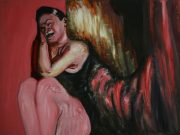Over the last year, ONUKA has shot to critical and popular success both at home and in Europe. But front-woman Nata Zhyzhchenko’s greatest accomplishment may be fusing Ukrainian antiquity with electronic modernity and responding to the times. Zhyzhchenko, the leading woman of the band ONUKA, is one of the brightest pop cultural phenomena of 21st century Ukraine. She is a musician capable of harmoniously blending folk traditions with urban sounds. She is an actress who also creates images and concepts as much as she does songs. And she is one of the heroines of the 2017 Eurovision Song Contest in Kyiv, the singer whose album “Vidlik” has reached the charts in ten countries.
Growing up in the 1980’s and 1990’s, Nata’s life was defined by two cities located 150 kilometers apart: Kyiv and Chernihiv. The capital was boiling with noisy life, while the more provincial Chernihiv (located close to the border with Belarus) held greater silence and nature. But both cities had music. Little Nata (she will be referred to as “Nata” for the rest of this article) was a soloist in a brass band located in Kyiv. And her grandfather Oleksandr Shlyonchik, a renowned builder of folk instruments, lived in Chernihiv.
A big city as well as a small one, global events and life away from turmoil, scenes of concert halls and a house where her ancestors worked, the rumbling of rhythm and the murmur of the chamber melody — these dualities formed Nata’s outlook, which mixes the traditions of the centuries and the innovations of a new epoch. And from this meeting of past and future, ONUKA was born.
The Girl With The Panpipes
When Nata was four years old, her grandfather taught her to play the panpipes. By the age of five, she had already toured with several local bands. At nine, she was performing as a soloist with various orchestras. At ten, she won the “New Names of Ukraine” musical contest. Nata’s parents, also musicians, encouraged their daughter’s musical endeavors.
Early on, young Nata attracted the adult world’s attention with the quality of her musicianship. People admired and praised her. It was during these early years, that she began composing her first works on the synthesizer.
But she had the classic “gifted childhood”: as she grew older, people lost interest in her. Nata explains the situation like this: “When a little girl is a virtuoso on the panpipes, it’s cool — there’s a ‘wow’ effect. But when it’s a 15-year-old girl, no one is interested”.
It was not an easy transition for Nata. She was not immediately able to get used to the idea that she was no longer seen as a child and so people reacted differently to her abilities. But Nata’s teenage years also helped her creative development in other ways. During this period, she grew closer with her elder brother Oleksandr, who would later become her bandmate.
Up until the age of fifteen, Nata’s life was filled with folk music. But Oleksandr opened her eyes to completely different phenomena: Pink Floyd and Depeche Mode. It was then that Nata’s interest in contemporary music formed. Thus, a new stage of her life began, but that did not mean that the previous years were crossed out. Her connection with tradition never stopped. And she maintained contact with the quiet and cozy city of Chernihiv, where she still comes from time to time.
“We cook food with grandmoa and have dinner in the fresh air in the garden”, Nata says of her time in Chernihiv. That little girl who spent part of her childhood away from the hustle and bustle of the pulsating city has not gone away. She lives on inside ONUKA; she’s a part of it.

Electronica and Tomato Jaws
Oleksandr was eight years older than Nata, but his interests and his social circle became a source of guidance for her. She often spent time at the recording studio with him, where she learned the process of creating modern electronic music. Her brother also gave her DJing lessons. Now Nata began to make records and dreamed about performing on stage.
In 2005, when Nata was 20, her brother invited her to join his musical project, Tomato Jaws. The band recorded an album and performed concerts, including some at the legendary Kazantip rave festival in Crimea. One of Tomato Jaws’ compositions was even released by a record label in Ireland. The team toured abroad, and performed on the same stage as such world electronica stars like Telepopmusic and Apparat.
During this time, Nata made a decision: instead of training in vocals at the music institute, she would study ethnocultural studies. While exploring the depths of modern sound together with Tomato Jaws, she also studied the roots of Ukrainian culture. This experience helped her to more subtly and accurately convey the vibrations of her native land in music.
Despite the success of Tomato Jaws, electronic music was far from mainstream in Ukraine a decade ago. It took the audience time to understand that people with laptops onstage are also artists. After a surge of popularity, Tomato Jaws eventually fell into decline and dissipated. By 2013, Nata was starting her own project.
By that time, something important had also happened: Nata met the DJ, sound producer and musician Eugene Filatov, creator of the project “The Maneken”. Filatov subsequently became her husband and the producer of ONUKA.
ONUKA and “Misto”
ONUKA was created by three people: Nata, Eugene, and the well-known Ukrainian costume designer Lesia Patoka. Their new music and image stressed the particular mix reverberating through their songs: a combination of the archaic and the modern. In the first ONUKA photo session, Nata wore her panpipes as a headdress. No one before her had managed to look so fresh and urban, while emphasizing a connection with the folk tradition.
Between December 2013 and October 2014, the group released its first song and music video, recorded a mini-album, had its first concert, and debuted its major album. At the same time, the war had began in Ukraine’s eastern Donbas region and Ukrainian society began to quickly break down many parts of its patrimony of Soviet consciousness. A general interest in deeper cultural roots began to grow. The new generation of young Ukrainians who only knew the Soviet era from the stories of their parents understood ONUKA’s unique rhythms as outside of that history. Less than a year after being founded ONUKA was gathering a thousand people for a concert.
In modern music, the rise of any pop artist is built on the success of at least one of his or her songs. For ONUKA, that song was “Misto”. It was born in torment. “At first it was in English, then in two languages. I rewrote the text three times. For the first time in my life, it took me so long to decide on the final version”, Nata explains. Finally, the song was recorded in Ukrainian. A few months later, it could be heard everywhere — on the radio, in stores, on public transport, booming out of cars on the street.
ONUKA’s music became a new cultural channel that connected Ukraine with the rest of the world. She spoke to her listeners in English and Ukrainian. But her communication was understandable without any translation: through rhythms, melodies, timbre, images. The echo of historical musical forms resonated with the sound of the 21st century, linking the present to the future and the future. Such a message is understandable without words. And, in the summer of 2015, ONUKA successfully performed in Budapest at Sziget, one of the largest festivals in Europe. ONUKA was going west.

Chernobyl and “1986”
In April 2016, Ukraine commemorated the 30th anniversary of the Chernobyl nuclear disaster, a cataclysm of global significance that haunts the country to this day. For Nata, it was an extremely personal event. Her father took part in “eliminating the consequences of the accident”, to use the former Soviet euphemism for the cleanup work. The now dead city of Pripyat near Chernobyl, evacuated after the accident is one of the most attractive places in the world for her. “On a global scale, human progress is evil”, Nata says. “In every human interaction with nature there is a negative side effect. Only it acquires a different scale depending on which technology is being used”.
She expressed these reflections on the fate of the Earth in her song “1986”:
And life is too short, and death is so sure
And nothing for tomorrow has left.
And nothing for tomorrow has left.
The song samples recordings of dispatchers from the Chernobyl nuclear plant. It also features the theremin, an unusual electronic instrument Nata learned to play for the sake of performing “1986” onstage. The song became one of four that were included in the mini-album “Vidlik”, which marked a new stage in the history of ONUKA.
The soft and cozy images of 2014 were replaced by severe and warlike ones. Harsher rhythms and aggressive sounds appeared in Nata’s music. ONUKA was reacting to the times: the more disturbing the world around her, the sharper the topics that Nata touched. And her live performances grew more expressive, with stronger emotions and more dance. ONUKA appeared to follow an actual pulse, to feel destructive forces’ global pressure. Nata’s response became more categorical: “I breathe, want to stop the talk”, she sings in the song “Vidlik”, and it sounds like an uncompromising reaction to any attempts to impinge upon freedom.
It was this energy that likely enthralled the European public when ONUKA appeared on television screens in May 2017. The 21st century world is filled with growing fear and a general sense of uncertainty, and the music of ONUKA addresses those anxieties.
Eurovision and Europe
“I absolutely cannot imagine myself at the Eurovision. I cannot sing at a level that would adequately represent Ukraine. In our country, many sing better than me”.
That’s what Nata Zhyzhchenko said last spring. One year later, she appeared onstage at Eurovision. But she wasn’t there to participate. Rather, she was an honored guest at the song contest.
On May 13, ONUKA and the NAONI Orchestra performed at the 2017 Eurovision Song Contest, which was hosted in Kyiv. They performed “Megamix”, which consisted of fragments of several of Nata’s songs. Two days later, “Vidlik” broke into the charts in France, Great Britain, Germany, Switzerland and several other European countries. Viewers were so impressed by the performance that they immediately started buying ONUKA’s music — and not just online, but also in vinyl.
The official ONUKA Facebook page got tens of thousands of new subscribers from outside Ukraine. Internet users left thousands of ecstatic comments on the “Megamix” video on Youtube in English, Spanish, German, and other languages. Then, in October and November, ONUKA went on tour. Audiences in Germany, Holland, the Czech Republic, Poland and Latvia saw Nata Zhyzhchenko perform with their own eyes. Fans left comments on her Facebook page: “When will you perform in Paris?” and “Come to London!”
November was a productive month for Nata’s project. Her song “Guns Don’t Shoot” premiered. It lays out a clear message for its listeners. “An ancient man picked up a stone and a stick. Since then, weapons and wars have always accompanied our history: a sword, a spear, a rifle, an atom”, Nata explains. “In the future, weapons will be more complicated: [Facebook] likes, smartphones, control over media-people…”
ONUKA’s new militaristic images remind us that we are all responsible for the wars we start. We may choose not to listen to her message. But, in the future, we cannot say that we were not warned. And we can be sure that Nata Zhyzhchenko will continue to have her finger on the pulse.
Igor Panasov is a music critic living in Kyiv.




































